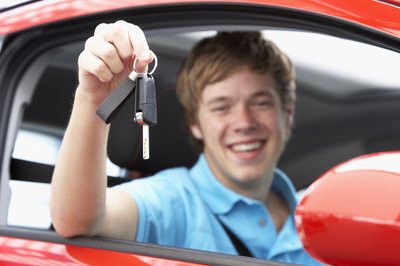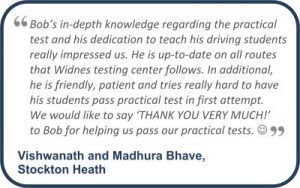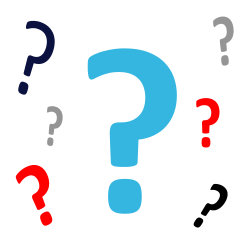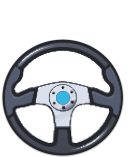Driving Test – Practical
What You Need To Know
“Practice Makes Perfect”

It’s natural to be a little nervous when taking your driving test but – with the right lessons, guidance and practice – there is no reason why it shouldn’t be one of the best days of your life.
At Bob’s Safe Drive, we’ll ensure that you will have learnt and practiced every part of the driving test many times (it does follow a standard format and usually lasts about 40 minutes) and of course you’ll be familiar with whatever route the instructor asks you to drive. On the actual day of the test we’d encourage a lesson beforehand, where you decide what you’d like to concentrate on – be that certain manoeuvres, dual carriageway or town driving etc.
Booking your practical driving test
- We’ll be able to advise you which of the local driving test centres is best for you; here’s a link to help you find the nearest to you: http://www.dft.gov.uk/fyn/practical.php
- Before you book, check with us that we are available on the day, especially if you are using the school’s car; you have the option of your instructor being present in the car and of course you’ll need some practice before the test begins
- You can book online or call the Driving Standards Agency – this link has the info you’ll need, including help with cancelling or changing the date:
https://www.gov.uk/book-practical-driving-test#before-you-start
What happens on the day of your driving test
- Eyesight test
- Driving Standards Agency “Show me, Tell me” Vehicle Safety Questions
- The driving element of the test
- Time to find out: Pass or Fail?
When you meet the DSA examiner, you’ll be asked to show your provisional licence and theory test pass certificate.
 Eyesight test
Eyesight test
An eyesight test comes next and you must pass this in order for the rest of the test to continue. It involves reading a number plate from a distance of:
- 20 metres for vehicles with a new-style number plate
- 20.5 metres for vehicles with an old-style number plate

 Driving Standards Agency;
Driving Standards Agency;
“Show me, Tell me” Vehicle Safety Questions
After checking your eyesight and before the actual driving part of your practical test begins, the driving test examiner will ask you one out of a range of questions. These are designed to ensure that you have a basic knowledge of keeping your car legal and safe and that you can carry out safety and maintenance checks for the vehicle.
You’ll be asked one “Tell me” question, which you’ll need to answer by verbally explaining to the examiner how you would carry out the check. Note that whilst driving you will be asked one ‘show me’ question e.g., showing how to turn on the heated rear window.
Should you answer either of the two questions incorrectly or fail to answer them at all, you will not automatically fail your test but you’ll incur one driving test minor fault. Hence, whilst it is very important to be able to answer these questions, if you do fail to do so, it’s best to put it behind you and concentrate on the practical driving part of the test.
The current range of “Show me, Tell me” questions can be found here, with more information and a couple of simple but informative videos.
 The driving element of the test
The driving element of the test
The driving element of the test will start once you and the examiner are comfortable in the car and you have checked everything from mirrors to your seat belt – what’s known as a “cockpit drill”.
If you are using your own car then ensure it is fully insured, has an MOT if applicable and is completely road-worthy.
(You’ll have made the decision whether to have your driving instructor in the car with you or not. One advantage of this is that we can observe how you drive during your test from an “examiners” viewpoint – it’s better than simply getting some feedback from the examiner. It means that IF you fail your test, we’ll have a better idea what to concentrate on when you resume lessons and practice).
- The test will take about 40 minutes and in that time the standard and safety of your driving ability will be assessed throughout a variety of different types of road and traffic conditions – for example you may encounter roundabouts, pedestrian crossings and be asked to drive on dual carriageways. Your knowledge and application of the Highway Code will also be examined.
- You simply continue driving until the examiner asks you to do something different, such as an emergency stop for example.
Note that you’ll be asked to do one of three possible reversing manoeuvres:
- Parallel park at the side of the road
- Park in a bay – either driving in and reversing out, or reversing in and driving out (the examiner will tell you which you have to do)
- Pull up on the right-hand side of the road, reverse for 2 car lengths and re-join the traffic.
- Independent driving section of the test (introduced in 2010)
There will be approximately 20 minutes of independent driving which tests how you make your own decisions and that you’ll be able to drive “in the real world” once you have passed. Most candidates will be asked to follow directions from a sat nav.
Given the changes that were introduced to the driving test on 4th December 2017, we’d suggest you take a look at this web page for more information and a simple but informative video.
Time to find out: Pass or Fail?
At the end of your test your examiner will advise you whether you have passed or not and also give you feedback about how well you did.
You’ll pass your driving test if you have driven:
- Without any serious or dangerous faults
- With fewer than 15 less serious faults
As the gov.uk website explains, there are 3 types of faults that can be marked:
- a dangerous fault – involves actual danger to you, the examiner, the public or property
- a serious fault – could potentially be dangerous
- a driving fault – not potentially dangerous, but if you make the same fault throughout your test it could become a serious fault
If you pass your test
You’ll be given a pass certificate and can start driving on your own immediately – you do not have to wait to receive for your full licence.
If you fail your test
You can take another test after 10 working days. Whenever you choose to re-sit your driving test, it’s a good idea to discuss what happened with your driving instructor and perhaps concentrate on anything that you still feel unconfident about. Of course you should also practice all aspects of your driving – to be ready to pass next time.




